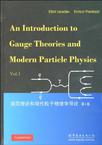规范理论和现代粒子物理学导论(第1卷)
出版时间:2010-4 出版社:世界图书出版公司 作者:(英)李德 著 页数:508
Tag标签:无
前言
for a book of its genre,our previous book,An introduction to gauoetheories and the"new physic"(1982)was a great success.It was not.alas,sold in airport lounges,but it did run to two additional printings(1983,198s),and to extensively revised editions in Russian(1990).and oin-Polish(1991).More importantly,it seemed to achieve the principal goal which we had set ourselves,namely,to present a pedagogical account ofmodern particle physics with a balance of theory and experiment,whichwould be intelligible and stimulating for both theoretical and experimental raduate students.We did not try to write a profound book on fieldtheory,nor a treatise on sophisticated experimental techniques.But wedid wish to stress the deep,intimate and fruitful interaction betweentheoretical ideas and experimental results.Indeed,for US,it iS just thisaspect of physics which makes it seem so much more exciting than say puremathematics our greatest pleasure came from the favourable reaction ofstudents who were working through the book and from those reviewerswho caught what we hoped was its essential flaV0ur——the writing createsthe reeling of an active progression of ideas arising from the repeatedinteraction of theoretical prejudice with experimental observation unlikemost textbooks,it is highly readable,and makes everything appear simpleand obviousWeII,the last comment iS surely an exaggeration but that was our aim.
内容概要
本书分为两册,详细地介绍了粒子物理学的现代理论和实验。条理分明,表述连贯。作者以简明直观的方式,阐释隐藏在实验现象背后的深刻的物理原理,同时循序渐进地讲解从事粒子物理研究用到的现代方法。本书收入了许多粒子物理领域的新成果,还有若干很有特色的议题,例如高阶弱电效应,夸克混合,喷流,深度非弹性轻子—强子散射,简单部分子模型的量子色动力学修正,以及量子色动力学的非微扰理论等。本书可以作为现代粒子物理学方向的研究生教材,对该领域的科研人员也有很好的参考价值。本书第一册主要包括电弱相互作用,新的基本粒子的探索及其物理性质的研究,部分子的发现,以及简单部分子模型的构建和预测等。第二册在介绍了CP破坏之后,主要讲解量子色动力学及其在“硬”过程中的应用,同时也介绍了“软”强子物理和非微扰量子色动力学。 读者对象:理论物理、高能物理和场论等专业的高年级本科生、研究生和相关专业的科研人员。
书籍目录
Preface Acknowledgements Notational conventions Note added in proof: the discovery of the top quark (?) Note added in proof: the demise of the SSC 1 Field theory and pre-gauge theory of weak interactions 1.1 A brief introduction to field theory 1.2 Pre-gange theory of weak interactions 1.3 The spin and isospin structure 1.4 Tests of the V-A structure and 'lepton universality' 2 The need for a gauge theory 2.1 The intermediate vector boson 2.2 Towards a renormalizable theory 2.3 Gauge symmetry 2.4 Freedom to choose the gauge 2.5 Summary 3 Spontaneous symmetry breaking: the Goldstone theorem and the Higgs phenomenon 3.1 Spontaneously broken symmetries in field theory: Goldstone's theorem 3.2 The Higgs mechanism 3.3 Unitarity and renormalizability 3.4 Suwmmary 4 Construction of the standard model 4.1 Model building (towards the standard model) 4.2 The standard model 4.3 Discovery of W and Z0 5 Lowest order tests of the SM in the leptonic sector 5.1 Phenomenology of purely leptonic reactions 5.2 A check of the minimal Higgs mechanism 5.3 Support for the SM from hadronic collider data 5.4 Concluding remarks 6 The Higgs boson 6.1 Introductory remarks 6.2 Higgs decay 6.3 Higgs production at the Z0 mass 6.4 Limits on the Higgs mass 6.5 Concluding comments 7 The standard model beyond lowest order 7.1 Radiative corrections 7.2 Renormalization and physical parameters 7.3 The effective fine structure constant 7.4 The muon lifetime revisited 7.5 Estimates of one loop corrections 7.6 Higher order corrections 7.7 Practical problems in testing radiative corrections 7.8 Strategies to overcome the imprecision in Mw 7.9 Testing the minimal Higgs mechanism 7.10 Beyond the standard model 8 e+e- physics and the standard model 8.1 Electron-positron storage rings 8.2 The new e+e- colliders: TRISTAN and LEP 8.3 e+e- physics at energies [[ Mz 8.4 e+e- and the standard model 8.5 LEP data near the Z0 peak 8.6 Determination of the SM parameters of the Z0 8.7 Neutrino counting 8.8 Asymmetries and polarization measurements at the Z0 peak 8.9 Conclusions 9 Extension to the hadrons; quark-lepton universality 9.1 Charm, bottom and top 9.2 Quark mixing 9.3 Electroweak interaction of the quarks 9.4 The GIM mechanism 9.5 Colour 9.6 Summary of the quark sector of the standard model 9.7 Quark masses and the KM matrix 10 Phenomenology of semi-leptonic reactions 10.1 Model independent tests 10.2 Parity violation in electron-nucleus scattering 10.3 Optical rotation 10.4 Summary 11 The discovery of the narrow vector resonances 11.1 Introduction 11.2 The 'new' particles 11.3 Some qualitative features of QCD 11.4 Quark-lepton parallelism 11.5 Flavour classification of hadrons 11.6 The J/ψ and the OZI rule 11.7 Experimental status of the J/ψ spectroscopy 11.8 Properties of the J/ψ(3097) and ψ'(3685) 11.9 Baryouic decay of J/ψ 11.10 The T family and its experimental status 12 Hidden flavour bound states 12.1 Quarkonium 12.2 J/ψ decays. Calculation of the widths 12.3 Determination of as 12.4 Leptonic widths 12.5 Exotics: glueballs, hybrids, etc. 12.6 ψ'→π: a puzzle 12.7 Conclusions 13 Open heavy flavours 13.1 Discovery and basic properties of charm and bottom particles 13.2 Charm decay 13.3 B physics 13.4 Production of heavy fiavours 13.5 Heavy fiavours at LEP 13.6 Final comments 14 The heavy lepton τ 14.1 Introduction 14.2 Discovery of the τ lepton 14.3 Properties of the τ lepton 14.4 τ decay 14.5 The τ neutrino 14.6 Rare τ decays 14.7 Miscellaneous and conclusions 15 Towards the parton model deep inelastic scattering 15.1 Electron-muon scattering 15.2 Elastic electron-proton scattering 15.3 Inelastic electron-nucleon scattering 15.4 Inelastic neutrino-nucleon scattering 15.5 Deep inelastic scattering and scaling behaviour 15.6 Polarization effects in deep inelastic scattering 16 The quark-parton model 16.1 The introduction of partons 16.2 Antipartons 16.3 Partons as quarks 16.4 The detailed quark-parton model 16.5 Charged lepton induced reactions for Q2 of order M2z 16.6 Behaviour of the quark number densities as x → 0 16.7 The missing constituents--gluons 16.8 The parton model in polarized deep inelastic scattering 16.9 Appendix to Chapter 16: The patton model as an impulse approximation 17 Experimental tests of the quark-parton model 17.1 Deep inelastic scaling functions for Q2 [[ M2Z 17.2 Neutrino cross-sections in the quark-parton model for Q2 [[M2Z 17.3 Cross-sections in the quark-parton model for Q2 comparable with M2Z 17.4 Application of the parton model to related processes Appendix 1: Elements of field theory A1.1 Fields and creation operators A1.2 Parity, charge conjugation and G-parity A1.3 The S-matrix Appendix 2: Feynman rules for QED, QCD and the SM A2.1 Relation between S-matrix and Feynman amplitude A2.2 QCD and QED A2.3 The SM A2.4 Some examples of Feynman amplitudes A2.5 Colour sums A2.6 The Gell-Mann SU(3) matrices A2.7 The Fierz reshuffle theorem A2.8 Dimension of matrix elements Appendix 3: Conserved vector currents and their charges References Analytic subject index for vols. 1 and 2
图书封面
图书标签Tags
无
评论、评分、阅读与下载
用户评论 (总计3条)
- 作者用规范场理论研究粒子物理.杨振宁教授提出规范场理论后,得到国际物理学界的普遍认可,很多物理学诺贝尔奖得主多次倡议:因为规范场理论而再次授予杨振宁诺贝尔物理学奖.
- 以前买了v2,所以这次把v1买了,书还没读,不过内容看来很丰富。
- 老外写的书,观点视角比较独特
